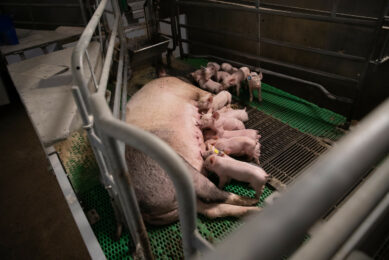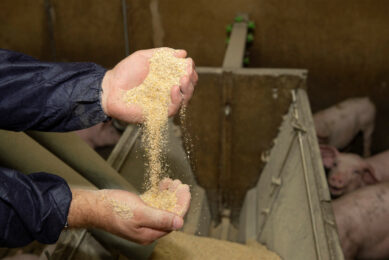Finisher pigs benefiting from phytogenics in feed

Much is said about the effect of phytogenic feed additives in piglets in the difficult time around weaning. How is their effect somewhat later in the production stage? Depending on the mix, benefits can be seen on FCR, carcass yield and lean meat percentage.
Phytogenics are materials of plant origin such as herbs, spices, essential oils or other plant extracts. They have been used for thousands of years for everyday purposes as flavouring substances as well as for their specific properties as natural remedies.
In nature, phytogenics and specifically essential oils play an important role. They attract insects, promoting the dispersion of pollens and seeds and repel other ones. In addition, essential oils may also act as antibacterials, antivirals, antifungals, insecticides or herbicides. They are aromatic oily liquids, volatile, characterised by a strong odour and can be synthesised by all plant organs (flowers, buds, seeds, leaves, twigs, bark, herbs, wood, fruits and roots). Phytogenic compounds can therefore be extracted from various parts of a plant, where they are stored e.g. in secretory cells, cavities or epidermic cells.

Dr Christine Hunger, Biomin: “In nature, phytogenics and specifically essential oils play an important role.”
Essential oils only represent a small fraction of the plant’s composition; nevertheless they confer the same characteristics found in aromatic plants that are used in the food, cosmetics and pharmaceutical industries. Essential oils have a complex composition, containing from a dozen to several hundred components. The aroma of each oil results from the combination of the sensory properties of all compounds, and even minor oil constituents may have major organoleptic roles to play. The different compounds in one essential oil act in a synergistic manner, that is, more than the mere summation of activities of the individual compounds.
The antioxidant activity of essential oils is another biological property of great interest because they can preserve foods from the toxic effects of oxidants. Moreover, essential oils being also able of scavenging free radicals can play an important role in the prevention of some diseases.
Phytogenics as feed additives
Since the ban on antimicrobial growth promoters (AGPs) in the EU and other countries, the search has been on for alternatives, with many studies conducted to look into replacements.
In the case of phytogenics, the anti-inflammatory and gut microbiota modulating effects in particular have been researched and the use of these compounds as feed additives has increased significantly in the last few years.
Adding a well-balanced mixture of phytogenics to the diet can increase the palatability of feed and therefore increase feed intake. The combination of different types of phytogenics, such as ground herbs and spices, essential oils and extracts, widens the scope for tapping into the whole spectrum of phytogenic properties and the potential that plants offer.
Figure 1 – Effect of a phytogenic feed additive** on digestibility of amino acids in piglets.
Effects on the animal
Research has shown that phytogenics are able to stimulate digestive secretions, like saliva or bile acids and the activity of digestive enzymes. These effects are proposed to be the core nutritional mode of action of phytogenics.
Through increased endogenous secretions, nutrient digestibility can be improved. Several studies conducted in different animal species have confirmed higher ileal digestibility of amino acids and better nutrient utilisation as a result.
Improved nutrient utilisation consequently deprives the gut microbiota of nutrients. In addition to anti-microbial activities, improved nutrient utilisation through essential oil compounds helps modulate and stabilise the gut ecosystem, which is especially important during feed changes and stressful situations.
Flavouring properties also improve feed palatability, thus reducing the risks of poor feed intake and digestive dysfunctions.
Enhanced digestibility entails a general improvement in feed conversion ratio (FCR). Higher protein digestibility results in better muscle accretion as shown in broilers as well as in pigs.
Effect on digestibility
The effect of a phytogenic feed additive (Digestarom, Biomin Phytogenics, Germany) on ileal digestibility is shown in Figure 1. The ileal digestibility was determined by pooling the results of two experimental trials. The pigs receiving the phytogenic feed additive had higher weight gains and a significantly better FCR (p<0.001>).
The ileal protein digestibility was improved by 9.8%. Figure 1 shows the significant improvement of different essential and non-essential amino acids.
Improved digestibility and therefore higher utilisation of dietary nutrients is of course an important aim, because feed is the main cost factor in animal production. Furthermore, with better utilisation of nutrients, especially of protein, less nitrogen is excreted in the form of ammonia.
Effects in finishing pigs
Phytogenics have been shown to improve feed intake, FCR, growth rate and carcass composition. In the following field study, the effect of Digestarom on performance parameters as well as on carcass characteristics of growing-finishing pigs was investigated. The trial included 5,732 finishing pigs in a total of ten commercial farms in Austria. The data of lean meat percentage in the different carcass weight (CW) groups is shown in Figure 2.
Figure 2 – Effect of a phytogenic feed additive* on lean meat yield compared to a control period.
The average lean meat percentage was improved in all CW-groups of finishing pigs that were fed the additive. The heavier the CW, the higher was the improvement in lean meat percentage through the phytogenic feed additive application.
Lean meat yield increased by 0.68 percentage points in the CW-group of 85-95 kg. At over 105 kg, lean meat percentage was 1.12 points higher compared to the control. This once more indicates better protein utilisation, as shown in Figure 1.
Potential
The use of natural substances like phytogenic feed additives and their beneficial effects on feed palatability and digestibility, especially of feed protein, is promising. These substances have great potential due to their ability to stimulate endogenous secretions and stabilise the gastro-intestinal tract through their gut microbiota modulating effect as well as through anti-inflammatory and anti-oxidant properties. The results have shown that phytogenic feed additives, depending on the mix of natural ingredients, can have a positive impact on the FCR as well beneficial effects like a higher carcass yield and quality (lean meat percentage) in pork production.
References available on request, contact the author at christine.hunger@biomin.net













